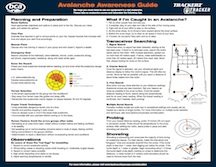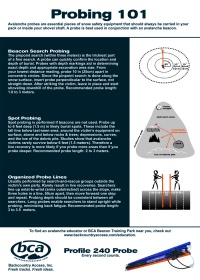Avalanche Safety: Knowledge Base
If you’ve found your way to this website, chances are you’re a mountain enthusiast, and like us, you’ll know the sheer exhilaration of off-piste and backcountry skiing or boarding; epic powder days are the times when we feel most truly alive. Here at Gravity Protection, our mission is to help our customers enjoy those days, again and again.
Avalanches are one of the most important dangers in the backcountry. In simple terms they happen when the strength of the snowpack is not able to support the weight placed on it. In a typical year, avalanches kill about 140 people in the Alps and North American mountains. Although we don’t want to over-emphasise the danger (the numbers affected are a very small proportion of the many hundreds of thousands of person-days spent backcountry skiing every year), the risk is there. However, there is good news. There is a lot that you can do to minimise the risk, so that arguably the most dangerous thing you do on your next backcountry ski trip is drive your car to the airport. The three factors to consider are knowledge, safety kit and practice.
Knowledge: The old adage about an ounce of prevention being better than a ton of cure fully applies here. It’s stating the obvious, but the best way not to get injured in an avalanche is not to get caught in one in the first place. And there is some very good news here- about 90% of avalanches are predictable, and so with the appropriate knowledge can be avoided. In addition, about 90% of avalanches involving skiers/boarders are started by the person involved. In other words they are not just random accidents, and by your actions (or perhaps as important, by masterful inactivity/avoidance) you can prevent yourself from becoming a victim.
The knowledge required to stay safe in avalanche terrain is a broad subject. If you're interested in mastering it yourself, we highly recommend attending a multi-day avalanche safety course, and there are many great providers in the UK, in the Alps, in North America and in New Zealand. In addition, there are many good online resources that will give you a flavour of the knowledge required, including how to assess the stability of the snowpack, the contribution of weather and the role of terrain, and give you an overview of the important human factors involved in avalanche incidents. There are also several excellent books on travelling safely in avalanche terrain. Then there's our own blog, which we hope will also give you some useful information. Alternatively, you can hire the knowledge and experience of an expert mountain guide or qualified ski instructor.
Safety Kit: While appropriate knowledge is extremely important, it is not infallible- there are many examples of highly experienced avalanche forecasters and mountain guides being caught in avalanches. When this happens, your life depends on you having the appropriate kit, and the ability to use it efficiently. If you are completely buried, you have a high chance of survival if you are dug out within 15 minutes, but with every minute after that your survival chances fall steeply; by 30 minutes your chances of being alive are probably less than 20%. Thus you MUST carry equipment that enables you to be found, or to find your friends if you are the rescuer. The following is the minimum requirement: a transceiver, a probe, a shovel. Each of these is critical. The transceiver is a dual function device- when set to transmit it sends out a radiofrequency signal which allows you to be located, whereas when set to receive it will detect the signal and allow you to find your buried buddy. The probe allows fine location of the buried person, while the shovel is essential to rapidly dig them out.
Recently, avalanche airbags have appeared in the armoury of the backcountry skier/boarder. These have been described as possibly the greatest advance in avalanche safety for the last 50 years. The statistics back this up, for example, 3% of people wearing an ABS airbag backpack who were caught in an avalanche and activated the pack died, compared to 20% of people in the same avalanches who were not wearing an airbag backpack; in other words, airbag use was associated with a significant reduction in the fatality rate. Here at Gravity Protection, we believe that airbag backpacks will soon be seen as essential kit for those venturing into avalanche terrain.
Practice: If one of your friends is caught in an avalanche, you have a golden 15 minutes to find them. This means that you should know how to use your safety gear efficiently, and this only come with regular practice. This is well recognised in other fields- for example, doctors undergo regular CPR training, since the relevant skills rapidly decay. There are several steps in an avalanche rescue; signal acquisition, the course search, the fine search, probing and digging. Practicing each of these steps, first in easy terrain, then in realistic terrain, will give the best chance of a successful outcome in the real situation.


